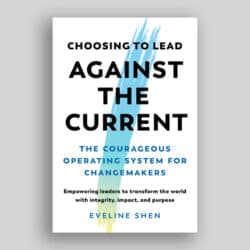Nearly one million workers in Canada’s not-for-profit sector lack a workplace retirement plan.
High-quality retirement plans with matching contributions are an effective way to build long-term employee financial health, and evidence shows that employees without a plan are unlikely to save enough for their retirement. To point, the median savings of households aged 55 to 64 without workplace pensions is just $3,000, according to a study by one leading income security expert, Richard Shillington.
Lack of access to quality workplace retirement plans in Canada’s not-for-profit sector means our employees are much more likely to experience financial stress than Canadians who have a plan. They are also much less likely to build the savings needed to escape poverty in their retirement. This, in turn, makes it hard for our sector to attract and retain the talent needed to effectively serve communities and tackle complex societal challenges.
To address this gap, a coalition of philanthropic funders, sector leaders, and the mission-driven business Common Wealth Retirement has been working to create the Common Good Plan, a nationally portable workplace savings and retirement program for workers in Canada’s not-for-profit sector. (It is structured as a Group TFSA/RRSP and is not a defined benefit plan. As a savings vehicle, it’s different from other options in the market because it focuses on monthly income, is sensitive to the needs of modest earners, and has low fees.)
After three years of consultation, feasibility research, design work, and operational preparation, the Common Good Plan has launched and the first cohort of not-for-profits from across Canada has enrolled.
The Pinnguaq Association is one of them. “As an emerging organization enthusiastic about maximizing employee benefits, we feel that the Common Good Plan is exactly what we were looking for: a well-managed and high-value option that fits with our mandate,” says CEO Ryan Oliver.
As we worked toward this moment, we repeatedly heard from not-for-profit employers that, while they were glad the plan would be available, they lacked the financial stability and resources to match their employees’ contributions. Employees would need to be content with their own dollars.
Despite the very real financial constraints that many not-for-profits experience, recently made worse by COVID-19, we believe there are ways our sector can do more to support our employees and that the case for doing so is stronger than ever as they confront the financial impact of the pandemic on their savings, dreams, and future plans.
In the past, one of the legitimate reasons not-for-profit employers did not offer retirement plans was that smaller organizations could not access high-quality plans. Those available to them, especially if provided by major banks and insurers, often charged very high fees and were sold through brokers who charged high commissions. All of this ate away at the hard-earned savings of employees.
With high-quality options emerging for even the smallest organizations, the time has come for every not-for-profit employer to ensure that their workers have access to a quality workplace retirement plan that will give them the help they need and deserve to build their savings and long-term financial security.
“Too many Canadians face dire straits in retirement because they have never had access to a good retirement savings plan,” says Alan Broadbent, founder of the Maytree foundation. “Now Common Good, and hopefully other such plans that may come along, offers the solution that will really serve the long-term interests of employees, and that employers can and should embrace.”
A workplace-based plan, even with no employer contributions, is decidedly better than no plan at all, as employees with access to payroll-based savings are 15 times more likely to save than those without a plan. At the same time, participation in workplace plans with employer contributions is significantly higher still.
So how can not-for-profits take the next step and actually join in contributing to their employee plan? How much of a match should employers offer?
A recent CharityVillage survey found that the average employer contribution ranges from 4% to 5% of base compensation among employers who make contributions. If that seems like too big a leap, not-for-profits can provide a flat-dollar amount, which may be easier for employees to understand, or start at a lower percentage and increase the level over time, perhaps diverting a portion of planned salary increases into the retirement plan.
Offering a plan with matching contributions needn’t be prohibitively expensive. Research has shown that even a modest match of 25% of employee contributions can boost employee participation by 40%. Even a modest flat-dollar contribution amount by employers can materially boost employee savings.
Employers can also ask their employees what they would prefer. A recent Abacus Data survey commissioned by the Healthcare of Ontario Pension Plan found that 74% of Canadians would accept a slightly lower salary in exchange for a better (or any) workplace retirement plan, and 79% would rather their employer make retirement plan contributions than have that money as salary (this latter percentage was just as high among those whose finances had been badly affected by COVID-19).
There is a strong organizational business case for employers to contribute to a high-quality plan for their employees. Research has shown that the lifetime financial value of a good retirement plan can be worth hundreds of thousands of dollars to a typical Canadian, meaning that retirement plan contributions are highly efficient ways to compensate employees. Contributing to a retirement plan can also reduce employee financial stress, a drain on workforce productivity costing the economy nearly $16 billion per year, according to Canadian Payroll Association estimates. Providing a retirement plan with an employer match can also help boost recruitment and retention of talented employees, a priority in every sector.
“Like all employers, we want to be able to attract and keep great people. A robust saving plan that enables staff to build their financial security can help us to do that. From our perspective, it’s a great investment for our staff and in the future of our organization,” says Elizabeth Mulholland, CEO of Prosper Canada.
To reap these benefits, though, organizational boards must move beyond narrow risk- and cost-management thinking to consider the benefits of a more financially secure, engaged, and committed workforce. Government and philanthropic funders (universally well compensated) also need to abandon the notion that quality community services can be bought at the expense of the people delivering them and explicitly budget for decent employee benefits and encourage their grantees to support the financial security of their workers.
While it is tempting to adopt a scarcity mindset when not-for-profit sector revenues have plunged and demands have never been higher, this is the very reason we need to invest in the people we are relying on to help Canadians through this challenging time.
While some of us are reaping a pandemic windfall from forced savings and working from home, we now know that others engaged in lower-wage frontline work are overwhelmingly bearing the brunt of both the disease and lost jobs and earnings. As a result, many are seeing their earnings, savings, and futures slip away.
“For years, we have been looking for a retirement plan to offer our staff that would be affordable for both the employer and the employee. Our staff are there for some of the most vulnerable people in our communities, 24 hours a day, every day,” says Susan Davis, executive director of the Gerstein Crisis Centre, part of the first cohort to join the Common Good Plan. “As an employer, we want to be there for them, providing them with a pathway to retirement that offers the security they have earned throughout their careers. Until now, our options have been limited due to lack of affordability, high fees, poor portability, and inflexible payment schemes. The Common Good Plan will provide us with a workable solution that understands the non-profit world.”
If we really are all in this together, we need to even the playing field and give every worker a path to a decent and secure retirement. Charity starts at home, so what better place to begin than with our own employees?
We now have decent, affordable retirement-plan options for not-for-profit workers – so if not us, then who?
The authors of this piece are members of the steering committee for the Common Good Plan.


